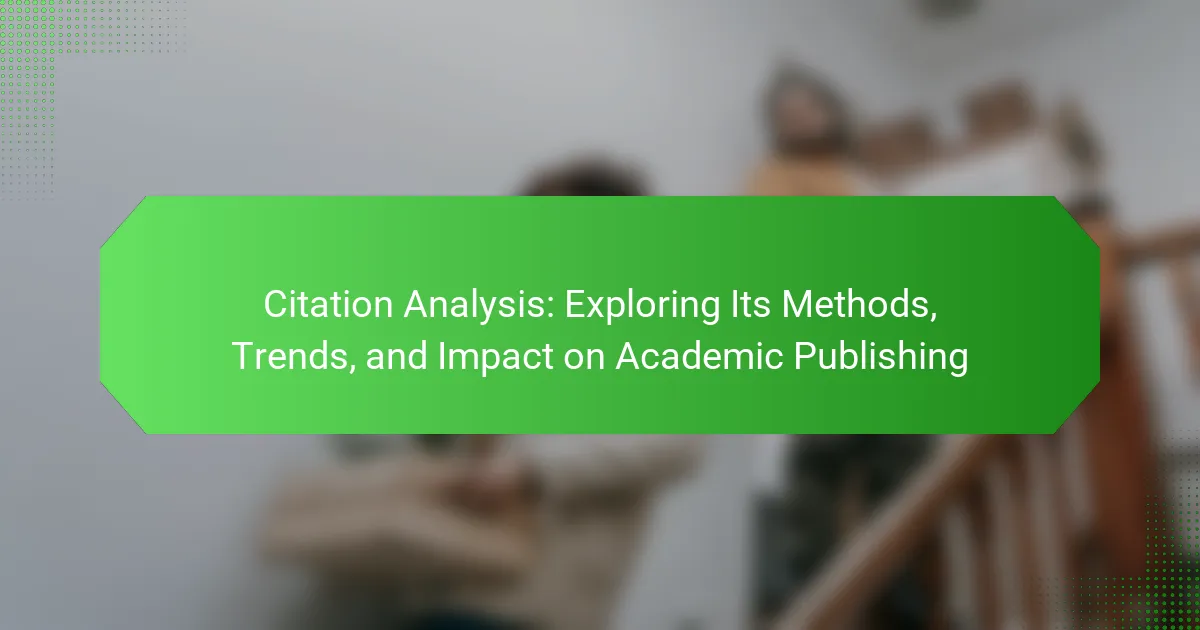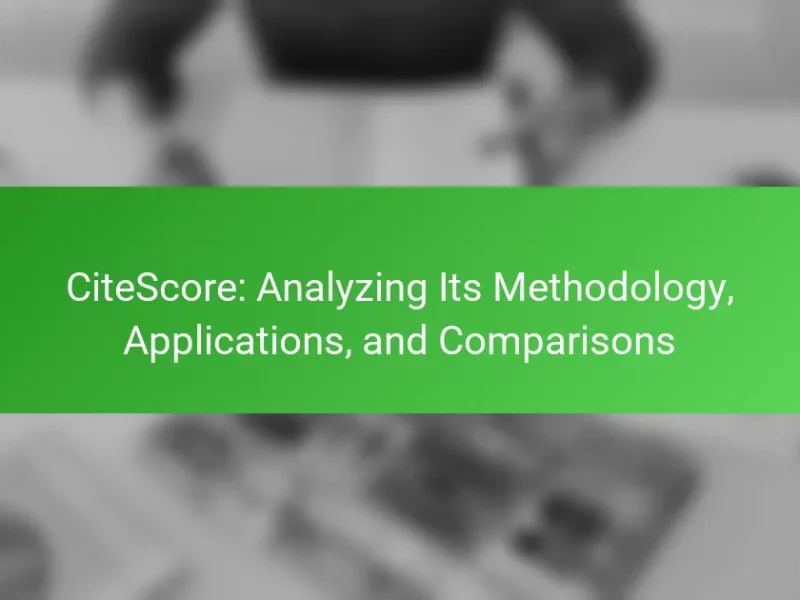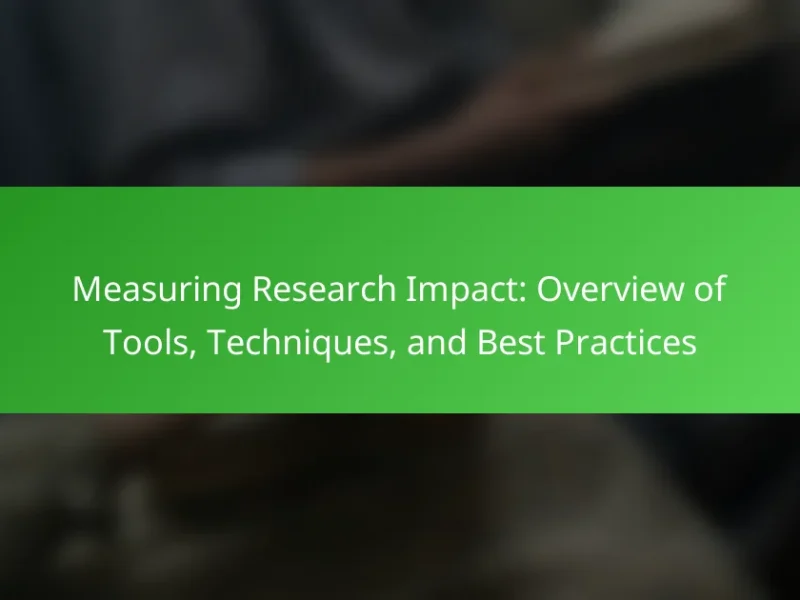Citation analysis is a quantitative method used to evaluate the impact of academic publications by counting citations from other works. This method assesses the influence and relevance of research, revealing trends in scholarly communication and identifying key authors and publications. The article explores various methods of citation analysis, including bibliometric analysis, co-citation analysis, and citation context analysis, as well as emerging trends such as artificial intelligence integration, altmetrics, and open access publishing. It highlights the significant role of citation analysis in academic publishing, influencing journal rankings, funding decisions, and research quality. Overall, citation analysis shapes the academic landscape by providing insights into research impact and collaboration across disciplines.
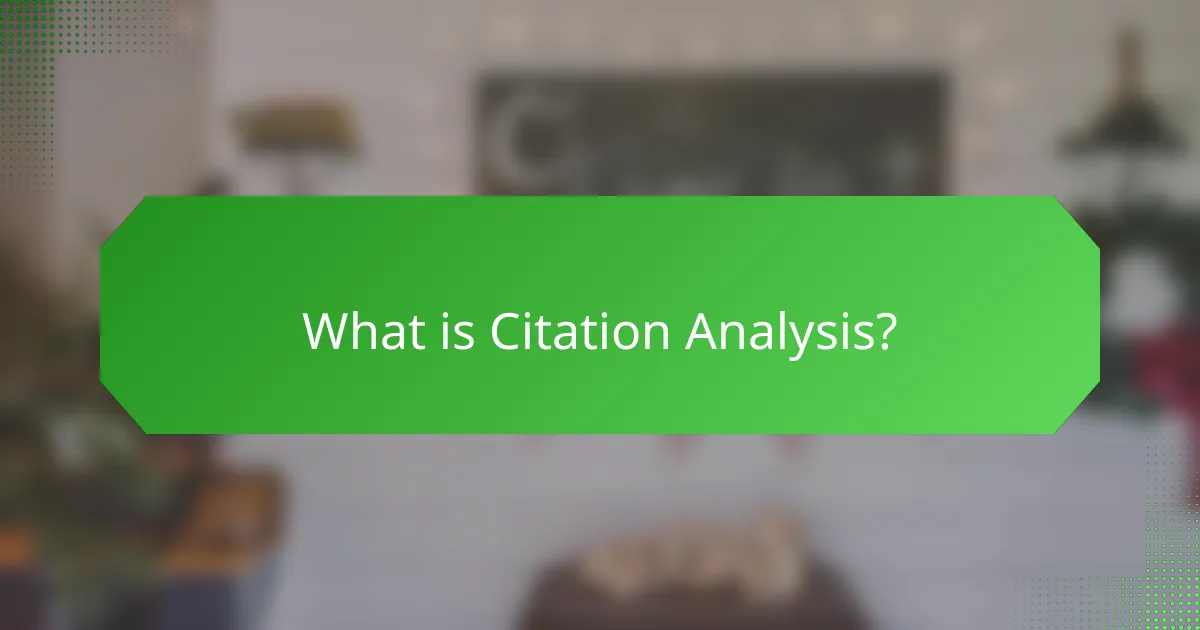
What is Citation Analysis?
Citation analysis is a quantitative method used to evaluate the impact of academic publications. It involves counting the number of times a publication is cited by other works. This method helps assess the influence and relevance of research within a specific field. Citation analysis can reveal trends in scholarly communication and identify key authors and publications. It is often used in academic publishing to measure the performance of journals and researchers. Studies show that highly cited works tend to have a significant impact on their respective disciplines.
How does Citation Analysis function in academic research?
Citation analysis functions by evaluating the references and citations within academic literature. It helps researchers assess the impact and relevance of scholarly articles. This method identifies which works are influential based on how often they are cited by others. Citation analysis can reveal trends in research topics and the evolution of academic fields. It also aids in determining the credibility of journals and authors. Studies show that highly cited papers often correlate with significant advancements in their respective fields. Citation analysis is utilized in various metrics, including the h-index and impact factor, to quantify academic productivity and influence.
What are the key components of Citation Analysis?
The key components of Citation Analysis include citation counts, citation networks, and impact factors. Citation counts measure the number of times a work is referenced in other publications. Citation networks illustrate the relationships between various works through their citations. Impact factors assess the significance of a journal based on citation frequency. These components help evaluate the influence and relevance of academic research. Studies have shown that higher citation counts often correlate with increased visibility and credibility in the academic community.
How do citations impact the credibility of research?
Citations enhance the credibility of research by providing evidence of the sources used. They demonstrate that the researcher has engaged with existing literature. This engagement shows a foundation of knowledge in the field. Furthermore, citations allow readers to verify the information presented. They also indicate the research’s scholarly context. Research with numerous citations often gains higher trust from peers. A study published in “PLOS ONE” found that highly cited papers are perceived as more credible. This perception influences the acceptance and impact of the research within the academic community.
Why is Citation Analysis important in academic publishing?
Citation analysis is important in academic publishing because it measures the impact and relevance of research. It provides insights into how often a work is cited by other scholars. High citation counts often indicate influential research that contributes significantly to its field. This metric helps researchers assess the visibility and reach of their work. Additionally, citation analysis informs funding bodies and institutions about research quality. It plays a crucial role in academic reputation and career advancement. Studies show that citations correlate with the perceived quality of research outputs. Thus, citation analysis serves as a key indicator of academic success and influence.
What role does Citation Analysis play in evaluating research quality?
Citation analysis serves as a critical tool for evaluating research quality. It quantitatively assesses the impact and relevance of scholarly works through citation counts. High citation counts often indicate that a research paper is influential and widely recognized in its field. Citation metrics can also reveal trends in research topics and the evolution of scientific discourse. Additionally, citation analysis helps identify leading researchers and institutions based on their publication impact. Studies show that papers with higher citation counts tend to be published in reputable journals. Thus, citation analysis plays a significant role in determining the quality and credibility of academic research.
How does Citation Analysis influence funding and grant opportunities?
Citation analysis influences funding and grant opportunities by demonstrating the impact and relevance of research. Funding bodies often prioritize projects with high citation counts, as they indicate scholarly recognition. A strong citation profile can enhance a researcher’s reputation, making them more attractive for grants. Additionally, citation metrics can guide funding agencies in evaluating the potential success of proposed research. Studies show that grant proposals with solid citation evidence are more likely to receive funding. For instance, a 2020 study published in the Journal of Research Policy found a direct correlation between citation metrics and grant approval rates. Thus, effective citation analysis serves as a critical tool for securing funding in academia.
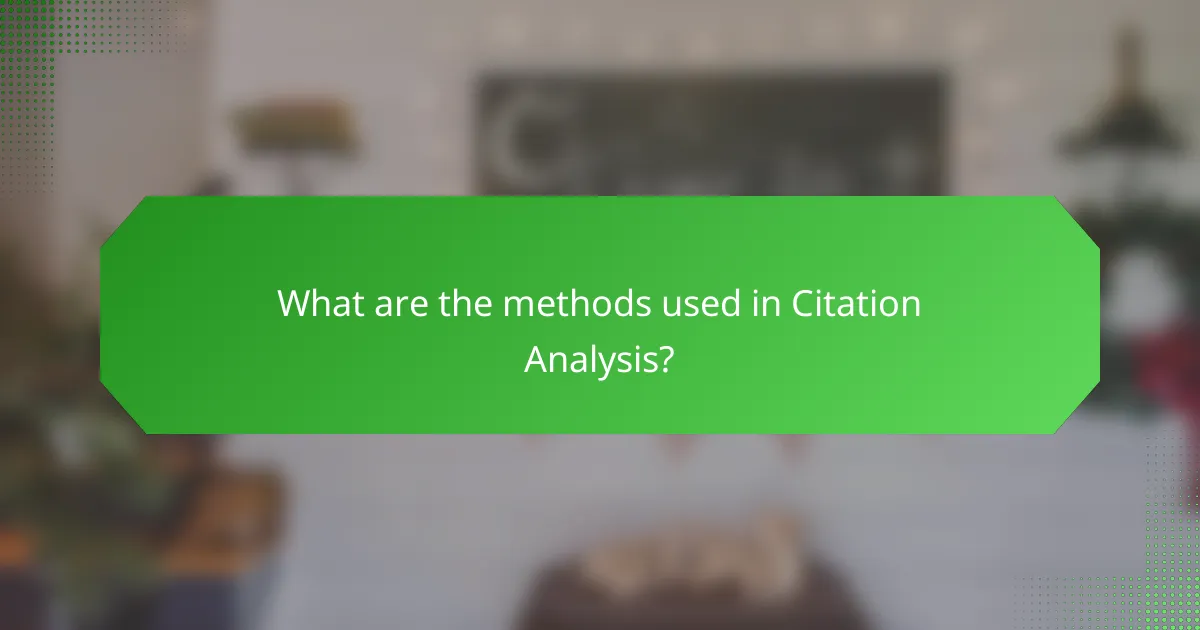
What are the methods used in Citation Analysis?
Citation analysis employs several methods to evaluate the impact and relevance of academic literature. Common methods include bibliometric analysis, which quantifies citations in published works. Another method is co-citation analysis, examining how often two works are cited together. This helps identify relationships between research topics. Additionally, citation context analysis evaluates the context in which citations occur. This method provides insights into how works are utilized in scholarly discourse. Furthermore, network analysis visualizes citation relationships among publications. This method highlights influential works within a field. Each of these methods contributes to understanding the academic landscape and the influence of research.
How do traditional Citation Analysis methods compare to modern approaches?
Traditional citation analysis methods rely on manual tracking of references in academic publications. These methods often focus on bibliometric indicators such as citation counts and impact factors. They typically analyze a limited set of data sources, primarily journals and conference proceedings. In contrast, modern approaches utilize advanced algorithms and big data analytics. They can process vast amounts of data from diverse sources, including social media and online repositories. Modern techniques also employ machine learning to identify patterns and trends in citation behavior. This allows for a more nuanced understanding of influence and collaboration in research. Studies show that modern methods can uncover insights that traditional methods may overlook, enhancing the overall analysis of academic impact.
What are the most common tools used for Citation Analysis?
The most common tools used for citation analysis include Web of Science, Scopus, and Google Scholar. Web of Science provides comprehensive citation data across multiple disciplines. Scopus offers extensive coverage of peer-reviewed literature and citation metrics. Google Scholar allows users to track citations and h-index for authors. Other notable tools are Publish or Perish, which analyzes citation metrics, and Dimensions, which provides citation and research impact data. These tools are widely used in academic research for assessing the impact and reach of scholarly work.
How do bibliometric methods enhance Citation Analysis?
Bibliometric methods enhance citation analysis by providing quantitative measures of scholarly impact. These methods utilize statistical tools to analyze publication patterns and citation frequencies. They allow researchers to identify influential works and authors within specific fields. Bibliometric indicators, such as the h-index and citation counts, offer clear metrics for evaluating research performance. Studies have shown that bibliometric analysis can reveal trends in research topics and collaboration networks. This data-driven approach supports informed decision-making in academic publishing. For instance, a study published in “Scientometrics” by Moed (2005) demonstrates the effectiveness of bibliometric methods in assessing research quality.
What are the limitations of current Citation Analysis methods?
Current citation analysis methods have several limitations. They often rely heavily on quantitative metrics. This can overlook qualitative aspects of research impact. Citation counts may not reflect the true influence of a work. They can be biased towards well-cited journals and established authors. Additionally, citation databases may exclude certain disciplines or types of publications. This leads to incomplete representations of research impact. Furthermore, citation practices vary across fields, complicating comparisons. Lastly, current methods may not account for self-citations, inflating metrics.
How can biases in Citation Analysis affect research outcomes?
Biases in Citation Analysis can significantly skew research outcomes. These biases may arise from factors such as publication bias, where studies with positive results are cited more frequently. This can lead to an overrepresentation of certain findings in the literature. Additionally, biases can occur due to the selective inclusion of citations based on the author’s reputation or the prestige of the journal. Such practices can distort the perceived impact of research.
Research shows that citation metrics are often influenced by social networks and academic hierarchies. For instance, a study by Bornmann and Daniel (2008) highlights that citation practices are not purely objective but are shaped by social factors. This can result in a lack of visibility for important but less-cited work. Consequently, critical research may be overlooked, leading to gaps in knowledge and potentially flawed policy decisions.
In summary, biases in Citation Analysis can lead to an inaccurate assessment of research significance, affecting the overall integrity of academic publishing.
What challenges do researchers face in conducting Citation Analysis?
Researchers face several challenges in conducting citation analysis. One major challenge is the quality and completeness of citation data. Inconsistent citation practices can lead to incomplete records. This inconsistency affects the reliability of the analysis. Another challenge is the varying definitions of what constitutes a citation. Different disciplines may have different standards. Additionally, researchers may encounter difficulties in accessing comprehensive databases. Some databases have limited coverage or require subscriptions. The sheer volume of literature can also complicate the analysis process. Identifying relevant citations among thousands of publications is time-consuming. Finally, interpreting citation metrics can be complex. Metrics such as impact factor can be misleading if not contextualized properly. These challenges can hinder the effectiveness of citation analysis in academic research.
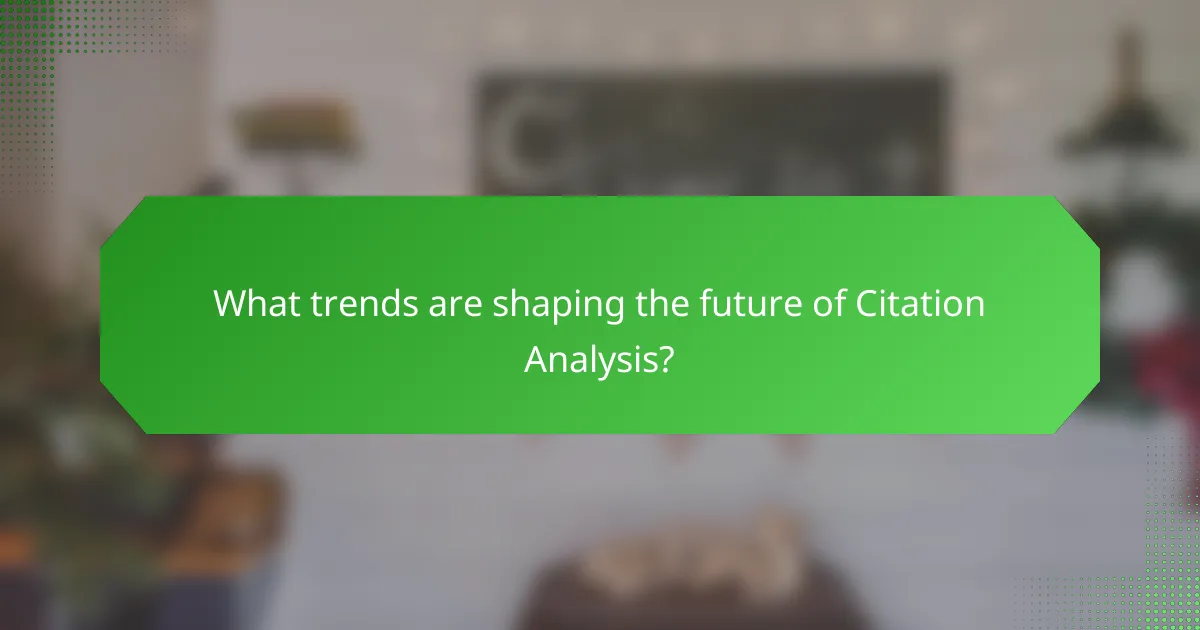
What trends are shaping the future of Citation Analysis?
Emerging trends shaping the future of citation analysis include the integration of artificial intelligence and machine learning. These technologies enhance data processing and pattern recognition in citation networks. Another trend is the focus on altmetrics, which measure the impact of research beyond traditional citations. This includes social media mentions and online engagement metrics. Additionally, there is a growing emphasis on open access publishing, which increases the visibility and accessibility of research. The increasing importance of interdisciplinary research is also notable, as it often leads to broader citation patterns across different fields. Furthermore, there is a trend towards more transparent and reproducible research practices, which may influence citation behaviors. These trends indicate a shift towards a more comprehensive understanding of research impact and collaboration across disciplines.
How is technology influencing Citation Analysis?
Technology is significantly influencing citation analysis by enhancing data collection and analysis capabilities. Advanced algorithms and machine learning techniques allow researchers to process vast amounts of citation data quickly. Tools such as citation management software streamline the tracking of references in academic work. These technologies provide real-time analytics, making it easier to assess the impact of scholarly articles. Additionally, online databases and platforms like Google Scholar and Scopus have expanded access to citation metrics. This accessibility promotes transparency in academic publishing. As a result, technology facilitates more comprehensive and accurate citation analysis, improving research evaluation methods.
What impact do big data and machine learning have on Citation Analysis?
Big data and machine learning significantly enhance citation analysis. They enable the processing of vast amounts of bibliometric data efficiently. This leads to more accurate identification of citation patterns and trends. Machine learning algorithms can uncover complex relationships between publications. They can also predict future citation impacts based on historical data. Big data tools allow for real-time analysis of citation metrics. This increases the responsiveness of academic publishing to emerging research trends. Studies show that these technologies improve the precision of impact factor calculations. Overall, big data and machine learning transform citation analysis into a more dynamic and insightful process.
How are open access publications changing Citation Analysis trends?
Open access publications are significantly altering citation analysis trends. They increase the visibility and accessibility of research outputs. This enhanced access leads to higher citation rates compared to traditional subscription-based journals. A study by Piwowar et al. (2018) found that open access articles are cited 18% more than their closed access counterparts. The shift towards open access is also influencing the metrics used in citation analysis. Traditional metrics may undervalue open access contributions. As a result, researchers and institutions are adapting their evaluation criteria to account for these changes. Open access is reshaping the landscape of academic publishing and citation practices.
What are the emerging metrics in Citation Analysis?
Emerging metrics in citation analysis include altmetrics, citation context analysis, and network analysis. Altmetrics measure the impact of research through social media and online engagement. Citation context analysis evaluates the reasons and context behind citations. Network analysis examines the relationships between cited works and their influence in academic fields. These metrics provide a broader understanding of research impact beyond traditional citation counts. They reflect the evolving landscape of academic publishing and the importance of diverse engagement metrics.
What is the significance of altmetrics in evaluating research impact?
Altmetrics are significant in evaluating research impact as they provide alternative metrics to traditional citation counts. They measure the attention and engagement a research output receives across various platforms. Altmetrics include data from social media, news articles, blogs, and other online sources. This broader perspective captures the immediate impact and relevance of research beyond academia. Traditional metrics often lag in reflecting current engagement levels. For example, a study by Priem et al. (2010) highlighted how altmetrics can reveal public interest and discussions around research. This indicates that altmetrics complement traditional metrics, offering a more holistic view of research impact.
How do social media interactions relate to Citation Analysis?
Social media interactions influence citation analysis by enhancing the visibility and dissemination of research. Increased engagement on platforms like Twitter and Facebook can lead to higher citation rates. Studies show that articles shared widely on social media are cited more frequently in academic literature. For instance, a study published in PLOS ONE found a strong correlation between social media mentions and citation counts in various fields. Social media serves as a catalyst for scholarly communication, bridging the gap between researchers and the public. This interaction can drive interest and encourage citations, thereby impacting academic publishing trends.
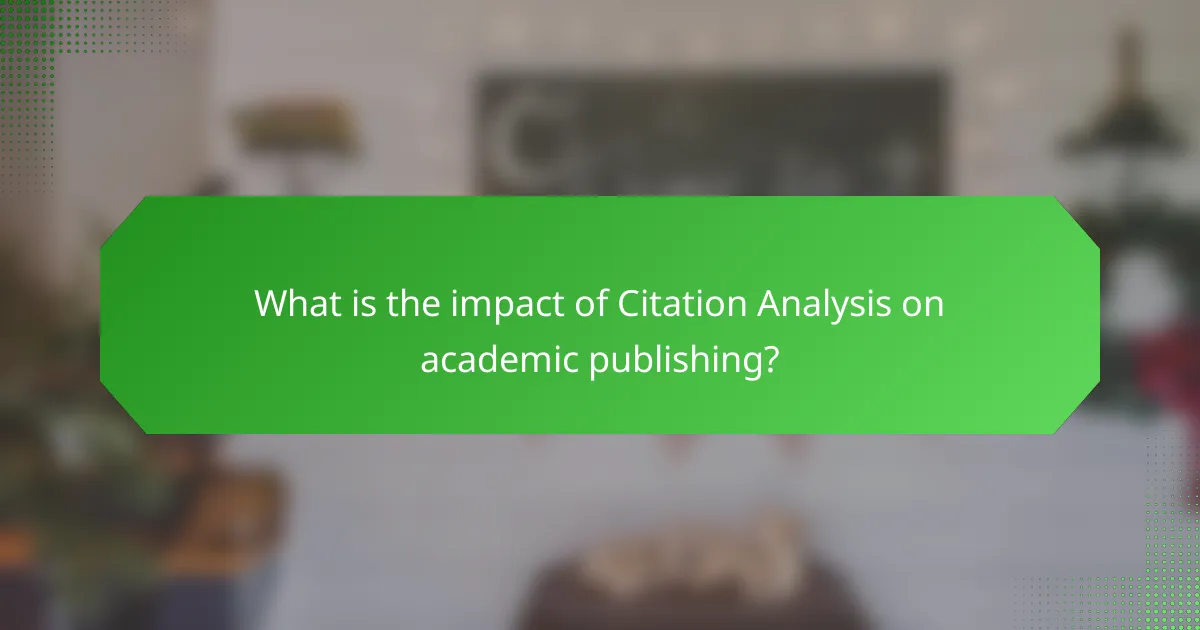
What is the impact of Citation Analysis on academic publishing?
Citation analysis significantly influences academic publishing by evaluating the impact and relevance of scholarly works. This method provides insights into how often a publication is cited by others. High citation counts often correlate with perceived quality and influence in a field. Publishers use citation metrics to assess journal rankings and impact factors. These metrics can influence funding decisions and academic promotions. Citation analysis also helps identify emerging trends and research gaps. It encourages researchers to produce high-quality, impactful work. Overall, citation analysis shapes the landscape of academic publishing and research evaluation.
How does Citation Analysis affect journal rankings and reputation?
Citation analysis directly influences journal rankings and reputation. It measures the frequency and context of citations received by articles published in a journal. High citation counts typically indicate strong influence and visibility in the field. This leads to higher rankings in metrics like the Journal Impact Factor. Journals with better rankings attract more submissions and readership. Consequently, a journal’s reputation improves as it gains recognition for quality research. Studies show that journals with rigorous citation analysis often maintain higher standards. This creates a feedback loop, enhancing both rankings and overall academic credibility.
What influence does Citation Analysis have on authors’ publishing strategies?
Citation analysis significantly influences authors’ publishing strategies by guiding their decisions on where and how to publish. Authors often select journals with high citation metrics to enhance visibility. This choice is driven by the understanding that higher citation rates can lead to increased readership and impact. Additionally, citation analysis helps authors identify trending topics within their field. By aligning their research with these trends, authors can increase their chances of being cited. Studies show that papers published in high-impact journals receive more citations, reinforcing this strategy. Therefore, citation analysis serves as a critical tool for authors aiming to optimize their publishing outcomes.
How does Citation Analysis contribute to the evolution of academic publishing standards?
Citation analysis enhances academic publishing standards by providing measurable metrics for evaluating research impact. It systematically assesses how often academic works are cited in other publications. This data informs journals about the relevance and quality of submitted articles. Increased citation rates can lead to higher journal rankings and influence editorial decisions. Moreover, it encourages researchers to produce high-quality, impactful work. Studies show that journals with rigorous citation practices tend to uphold higher academic standards. For example, the Journal Impact Factor relies heavily on citation analysis to gauge journal prestige. Thus, citation analysis plays a critical role in shaping the landscape of academic publishing.
What best practices should researchers follow in Citation Analysis?
Researchers should follow several best practices in citation analysis. First, they must define clear research questions or objectives. This focus guides the analysis and ensures relevant data collection. Second, researchers should select appropriate databases for citation retrieval. Popular databases include Web of Science and Scopus, as they provide comprehensive citation data. Third, it is essential to use standardized citation metrics. Metrics like h-index and impact factor offer consistent measures for evaluating research impact.
Fourth, researchers should consider the context of citations. Understanding the reasons behind citations can provide deeper insights into research influence. Fifth, they must ensure data accuracy by cross-verifying citations across multiple sources. This step helps mitigate errors in citation counts. Finally, researchers should document their methodology transparently. Clear documentation allows for reproducibility and validation of their findings. Following these practices enhances the reliability and credibility of citation analysis outcomes.
How can researchers effectively utilize Citation Analysis for their work?
Researchers can effectively utilize Citation Analysis to enhance their work by identifying influential papers in their field. This method allows them to track how their research is cited over time. By analyzing citation patterns, they can discover trends and gaps in the literature. Citation Analysis also helps researchers evaluate the impact of their own publications. They can use citation metrics to support grant applications and tenure reviews. Furthermore, it aids in selecting relevant literature for literature reviews. Tools like Google Scholar and Scopus provide accessible citation data. These platforms offer insights into citation counts and h-index calculations. Overall, Citation Analysis serves as a valuable tool for improving research visibility and credibility.
What tips can enhance the reliability of Citation Analysis results?
To enhance the reliability of Citation Analysis results, use a systematic approach to data collection. Ensure comprehensive coverage of relevant literature in your analysis. Utilize multiple citation databases to capture a wider range of citations. Cross-verify citation counts from different sources to confirm accuracy. Apply consistent criteria for selecting articles to analyze. Consider the context of citations, such as the publication year and journal impact factor. Employ statistical methods to assess citation patterns and trends. Regularly update your data to reflect the most current research landscape. These strategies will strengthen the validity of your citation analysis findings.
Citation analysis is a quantitative method used to evaluate the impact of academic publications by counting citations from other works. This article explores the various methods of citation analysis, including bibliometric analysis and co-citation analysis, while discussing its significance in assessing research quality, journal reputation, and funding opportunities. Key components such as citation counts, impact factors, and emerging trends like altmetrics are examined, alongside the influence of technology and big data on citation practices. The article also addresses the challenges and biases present in current citation analysis methods, providing best practices for researchers to enhance the reliability of their findings.
